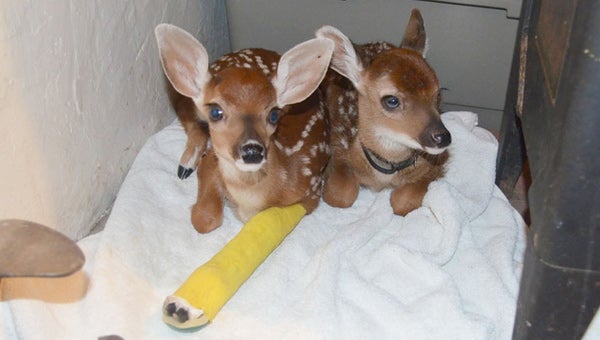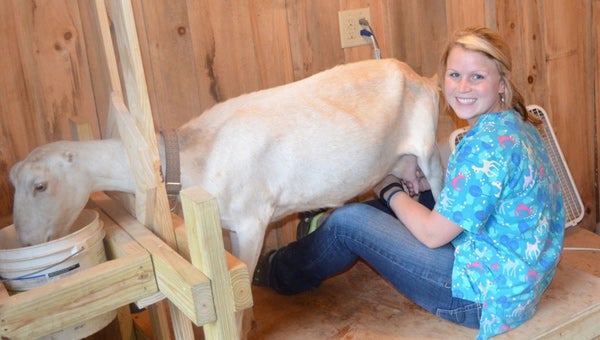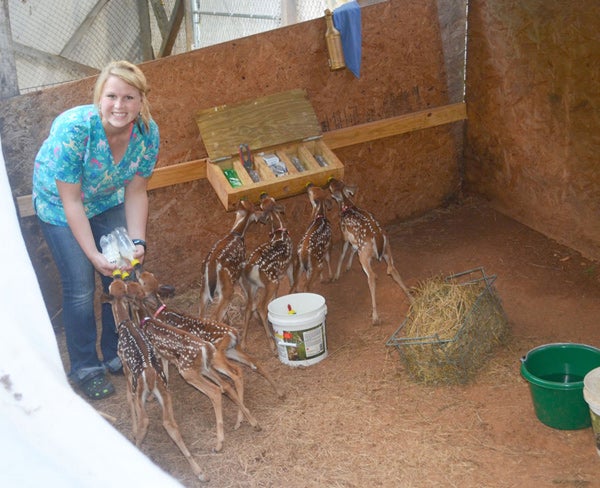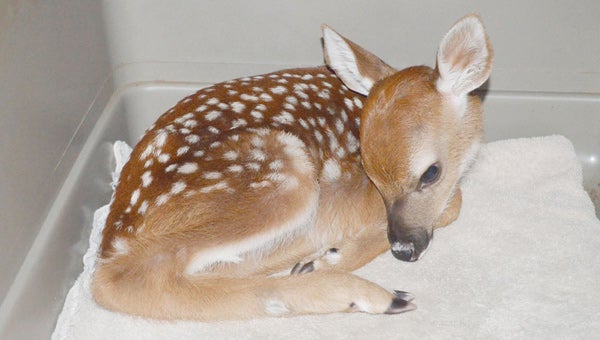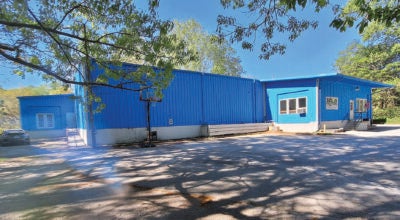Wildlife rehabilitator spends summer caring for fawns
Published 10:00 pm Thursday, July 10, 2014
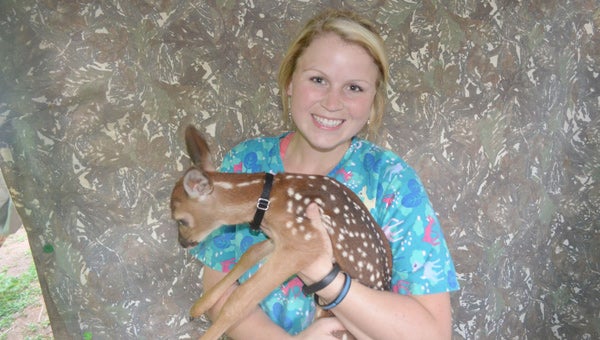
Billie Garrett with Silver Creek Fawn Rescue in Mill Spring who rehabilitates fawn deer. (photos submitted by Toby Jenkins)
While most others are planning vacations and barbecues, summer for a Mill Spring woman means work.
Billie Garrett, of Silver Creek Fawn Rescue in Mill Spring is a wildlife rehabilitator and since most wildlife species are born early summer, this is the time when things get busy.
Garrett started Silver Creek Fawn Rescue in 2011 and so far this season has rehabilitated 20 fawn deer from the area.
She is only one of 19 primary licensed fawn rehabilitators in North Carolina with only one other rehabilitator licensed in Polk’s district, who is in Macon County more than two hours from Polk.
Garrett has taken in fawns from as far away as Shelby, Morganton and Asheville. Last year Garrett rehabilitated eight fawns, feeding them every day for six months.
In order to feed the fawns, Garrett also raises goats for their milk. She gets up at 4 a.m. to milk the goats, feeding the goats twice a day and feeding the fawns three times a day. Garrett also works at Bonnie Brae Veterinary Clinic, where she takes her lunch break daily to return home for the fawns’ lunch feeding.
Following the fawns’ evening feeding around 7 p.m., Garrett checks the fencing and shelters to keep predators such as dogs and coyotes out. She gets no summer vacation, saying it’s not like she can just drop 20 fawns off with a friend to “deer sit.”
Garrett takes special care to ensure that the fawns remain “wild” and not accustomed to human behavior. If the fawns get used to human contact, it could be dangerous for both the deer and humans once they are rehabbed and released back into the wild.
Garrett and husband Jarvis have constructed covered sheds, outbuildings for storage and large fenced in lots to provide shelter for the fawns, but keep their habitat as close to natural as possible. It takes a large area and a lot of fencing materials to provide adequate space for the deer to have food, shelter and water and the Garretts have planted food plots to provide a natural food source for when the fawns get older to allow them to survive on natural foods in the wild. After a couple of months on the goats’ milk, Garrett purchases feed like grains and supplements to ensure that each fawn remains in excellent health. One of the biggest challenges the Garretts face other than hard work and long hours is the financial burden.
On average it costs about $600 for each fawn taken in to maintain it until it can be released back into the wild, which does not include the overhead costs of materials and labor for building and maintaining a quality facility.
Wildlife officers with the N.C. Wildlife Resource Commission inspect the rehabilitators’ facilities to ensure they meet state requirements.
“Garrett’s facility is well above what is required, but with over double the fawns that she has taken in this year as compared to last year she has to keep increasing the size of her facility and I can’t imagine the expense that this costs the Garretts out of pocket,” said Polk County game warden Toby Jenkins. “She is dedicated to her job, and we are fortunate to have her volunteering her time, services and own finances to support the cause. She goes above and beyond in her wildlife rehab services.”
Bonnie Brae donates their veterinary services to assist Garrett and has provided x-rays, medical supplies and treatment for Garrett’s deer.
Message from the N.C. Wildlife Resource Commission:
State law prohibits anyone from possessing wildlife in captivity unless you are a licensed rehabilitator. Of the fawns that require rehabiliation, 90 percent are picked up by people who think the fawn has been abandoned. A few of the fawns have been orphaned by collisions with vehicles or have been caught by a dog and injured. We get it. They are awfully cute, and many times look abandoned.
But the N.C. Wildlife Resources Commission is reminding the public that they should not approach, touch, feed or move fawns seen hiding in the grass, brush or other vegetation. Deer are a “hider species” — which means a female will hide her fawn in vegetation while she feeds elsewhere. She might not return for several hours.
So while the fawn might look abandoned and alone, it is often just waiting for the female to return.
The fawn is well-equipped to protect itself. By the time it is five days old it can outrun a human and by three to six weeks of age the fawn can escape most predators.
“Spotted and lacking scent, fawns are well camouflaged and usually remain undetected by predators. The doe will return to the fawn several times a day to nurse and clean it, staying only a few minutes each time before leaving again to seek food,” said Ann May, a wildlife biologist with the wildlife commission. “Touching, moving or feeding the fawn will do more harm than good.”
Humans usually cannot provide the proper care for the fawn, and moving it might stress it.
Raising a fawn as a pet is illegal in North Carolina and can lead to situations that are dangerous for the animal and humans alike. Wild animals that lose their fear of humans typically don’t survive in the wild and those that do often become threats to people. Deer that have no fear of people will sometimes exert aggression toward people resulting in serious injury.
In March, for example, a deer attacked a man in Utah. Wildlife officials say the mule deer did not fear people because it had been raised as a pet. Similar attacks have happened in North Carolina in recent years.
Unless a fawn is in imminent danger — for example, under attack by dogs or injured in a mowing accident — the best decision is to leave it alone. If you are concerned, leave the area and come back to check the fawn the next day. Do not remain in the area. A doe is very cautious and will not approach its fawn if she senses your presence.
If the fawn is in the exact location the following day and bleating loudly or lying near a dead doe (likely at the side of a highway), do not take the fawn into your possession. It is illegal to remove a fawn from the wild. Only licensed fawn rehabilitators may keep fawns in captivity for eventual release.
Instead, call the Wildlife Resources Commission at 919-707-0050 for the contact information of a local, permitted rehabilitator or see a list of fawn rehabilitators. Follow the guidance of the fawn rehabilitator.
June is the peak month for fawns being born in Polk County and it’s not uncommon for a healthy doe to have twins and sometimes triplets.
The state currently provides no funding for deer rehabilitation and licensed rehabilitators must foot 100 percent of the costs.
“If people would just leave the fawns alone when they find them they would be raised by a mother in the wild and it would be a lot less expensive on Garrett,” Jenkins said. “If there is evidence of the mother being killed, then the rehabilitator should be contacted, otherwise they should be left alone. The mother usually leaves the fawns for several hours at a time in between feedings.”
State and federal law prohibits any transportation of a wild animal, especially across state lines. Diseases are spread by people who pick up an animal from one area and transport it to another area to release it. Chronic wasting disease (CWD) has currently been found in deer in 19 states and two provinces in Canada., the closest being found in Virginia in 2011. Chronic wasting disease (CWD) is a transmissible spongiform encephalopathy (TSE) of deer and elk. TSEs are neurological diseases characterized by microscopic empty spaces in the brain matter, creating a “spongy” appearance. The disease prions attack the brains of infected animals, causing decreased interactions with other animals, listlessness, lowering of the head, a blank facial expression and repetitive walking in set patterns. Infected animals become emaciated and eventually die. To date, CWD has been found only in cervids (members of the deer family) in North America. Anyone willing to donate financially to assist Foothills Fawn Rescue may do so by PayPal account or by contacting Garrett at 828-748-1250 or by email at: blewis91@me.com.
Silver Creek Fawn and Rescue website can be found at: http://blewis91.wix.com/silvercreekfawnrehab#.


